Step-by-step breakdown of double infusion cannula technique for bullous keratopathy
Click Here to Manage Email Alerts
Pseudophakic or aphakic bullous keratopathy with a cloudy cornea requires some form of endothelial keratoplasty to replace the compromised host corneal endothelium with a healthy donor endothelium along with Descemet’s membrane, with or without adjacent corneal stroma, in order to restore host corneal clarity and visually rehabilitate the patient. Additional surgical maneuvers are piggybacked to the EK procedure when an existing IOL is suboptimal and requires an IOL exchange. In EK procedures, a secondary IOL is usually not placed within the anterior chamber as this would occupy space and create additional hurdles. Therefore, a secondary IOL is preferably placed behind the iris using scleral fixation of the secondary IOL utilizing a single- or double-point suture-fixation technique or, alternatively, a glued IOL technique in which the externalized IOL haptic is securely tucked within a scleral tunnel under partial-thickness scleral flaps that are 180° apart.
In aphakic bullous keratopathy cases, one surgical step is not required as the eye is aphakic and a secondary IOL is placed along with the EK procedure. In such aphakic cases, care should be taken during the EK procedure to avoid having the donor graft pass from the anterior chamber via the pupil into the posterior segment and even onto the retinal surface. In both aphakic and pseudophakic bullous keratopathy cases, with poor visualization of the anterior chamber, it is encouraged to mechanically remove the corneal epithelium, use side illumination and/or use an intraoperative slit lamp to improve visibility for the surgeon. Vitreous clearance from the anterior chamber is essential before introduction of the donor tissue into the anterior chamber. Further, intraglobal pressure maintenance is important, with only air used without any viscoelastic material, and an air bubble in the anterior chamber is the preferred technique for attaching the donor corneal disc with healthy endothelium to the recipient cornea.
In this column, Drs. Narang and Agarwal describe their surgical technique in a step-by-step format that includes pre-Descemet’s endothelial keratoplasty, IOL exchange with glue, secondary IOL placement and iris repair.
Thomas “TJ” John, MDOSN Surgical Maneuvers Editor
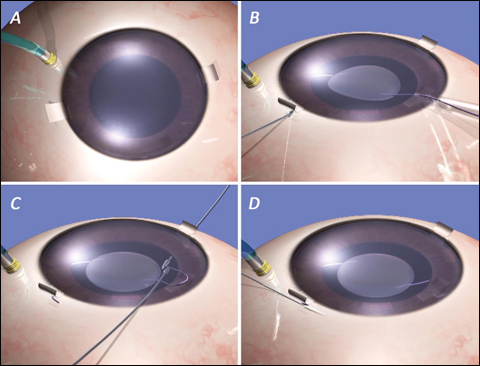
Source: Priya Narang, MS, and Amar Agarwal, MS, FRCS, FRCOphth
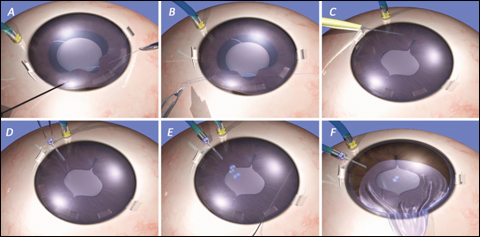

Double infusion cannula technique (DICT) is a surgical procedure that comprises placement of two infusion cannulas into the eye in cases with pseudophakic bullous keratopathy and/or aphakic bullous keratopathy scheduled to undergo a secondary IOL placement with pre-Descemet’s endothelial keratoplasty. Hypotony and graft adherence are the two major concerns in eyes undergoing secondary IOL placement with an endothelial keratoplasty procedure. DICT is a method in which two infusion cannulas are introduced inside the eye; the primary one is introduced for fluid infusion at the pars plana level, and the second one is introduced at the level of the limbus as a trocar anterior chamber maintainer (T-ACM) that is employed for air infusion inside the eye (Figures 1, 2 and 3).
Loss of anterior chamber tamponade often leads to graft dislocation in post-vitrectomy eyes. Hence, it is important to maintain the tonicity of the globe along with the placement of a fluid infusion cannula in the posterior segment and air infusion in the anterior segment. The technique of DICT strives to achieve this balance so as to enhance the graft apposition and eventually the optical outcome. DICT is aimed at solving both issues simultaneously, thereby decreasing the chances of complications and optimizing the surgical outcomes.
Placement of the first infusion cannula
The first infusion cannula is placed at the pars plana to introduce fluid inside the eye in cases with aphakic bullous keratopathy or pseudophakic bullous keratopathy in which it is planned to explant the existing faulty IOL and replace it with secondary IOL fixation with the glued IOL technique.
The initial procedure involves making two partial-thickness scleral flaps 180° opposite each other followed by introduction of the fluid infusion cannula at the pars plana site about 3 mm to 3.5 mm away from the limbus. The glued IOL procedure is performed, and the IOL is securely tucked into the intrascleral pockets (Figure 4 and Figure 5).
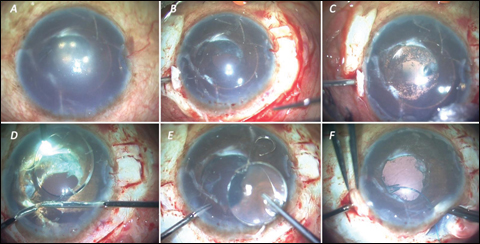
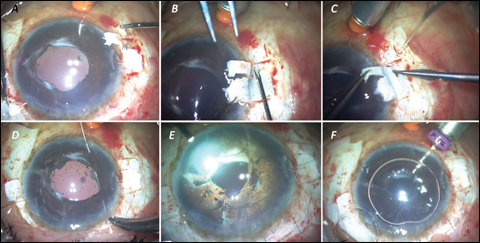
Placement of the second infusion cannula
Once the IOL is fixed, a T-ACM is introduced inside the eye at a distance of 0.5 mm away from the limbus, creating a biplanar wound. The T-ACM is introduced in a way that it enters the eye in front of the iris tissue into the anterior chamber. The T-ACM is attached to the tubing of the Constellation machine (Alcon), and air infusion is switched “on” with a pressure of 30 mm Hg. Descemetorhexis is performed, and the donor graft for PDEK is loaded onto the cartridge of a foldable IOL and injected inside the anterior chamber (Figure 6). The graft is gently unfolded by tapping the anterior surface of cornea, and once it is totally unfolded, air infusion is switched “on” with a pressure of 50 mm Hg for 30 to 45 seconds. After this, the pressurized air infusion is stopped, and no specific attempt to burp the air from the anterior chamber is attempted or needed as the posterior infusion cannula replaces some amount of air with fluid in a controlled way. The pars plana infusion cannula is removed, followed by the T-ACM. Pressure is applied over the entry site with a cotton tip applicator to avoid egress of air or fluid from the eye. Fibrin glue is then applied to seal the scleral flaps and the conjunctival wounds.
After placement of the first infusion cannula and fixation of the secondary glued IOL, the eye is effectively compartmentalized into the anterior and posterior chambers. The fluid infusion helps maintain the tonicity of the eye and prevents the globe from collapsing. Pressurized air infusion in the eye from the T-ACM helps vault the graft and adhere it to the recipient bed.
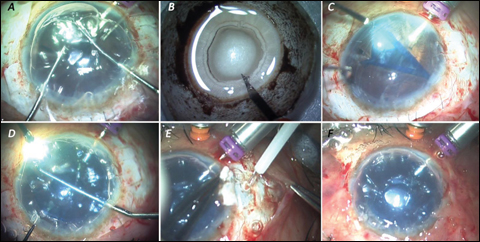

Performing DICT has various advantages such as no seepage of air into the vitreous cavity in both the intraoperative and postoperative periods as the posterior chamber is continuously maintained with fluid seeping into the eye from the pars plana infusion cannula. This helps in graft adherence. Moreover, after descemetorhexis air infusion from the T-ACM is stopped, the anterior chamber does not collapse as gentle fluid seepage occurs into the anterior chamber from the fluid infusion from the posterior vitreous cavity. This facilitates graft unfolding and maneuvering. Pressurized air infusion is switched “on” only when the entire graft has unfolded. DICT provides internal globe stability, prevents pressure fluctuations, and enhances graft stability and adherence, thereby making the surgery more surgeon dependent. The DICT procedure offers effective management with good postoperative results (Figure 7) in cases that necessitate an endothelial keratoplasty procedure with secondary IOL fixation.
- References:
- Agarwal A, et al. Br J Ophthalmol. 2014;doi:10.1136/bjophthalmol-2013-304639.
- Jacob S, et al. Cornea. 2017;doi:10.1097/ICO.0000000000001225.
- Narang P, et al. Cornea. 2017;doi:10.1097/ICO.0000000000001391.
- Price MO, et al. Annu Rev Vis Sci. 2017;doi:10.1146/annurev-vision-102016-061400.
- For more information:
- Amar Agarwal, MS, FRCS, FRCOphth, can be reached at Dr. Agarwal’s Eye Hospital, 19 Cathedral Road, Chennai 600086, India; email: dragarwal@vsnl.com.
- Priya Narang, MS, can be reached at Narang Eye Care & Laser Centre, Ahmedabad, India; email: narangpriya19@gmail.com.
- Edited by Thomas “TJ” John, MD, a clinical associate professor at Loyola University at Chicago and in private practice in Oak Brook, Tinley Park and Oak Lawn, Ill. He can be reached at email: tjcornea@gmail.com.
Disclosures: Agarwal, Narang and John report no relevant financial disclosures.
